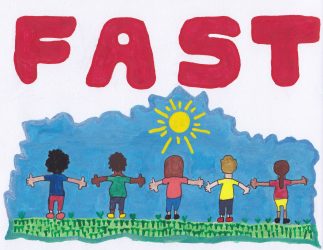Here is a story written by one of our families about the work our amazing therapists do with our children.
The Dreaded Playground
My pint sized ASD child at the tender age of nine is an aficionado at certain exploits in the playground. He is a dexterous master of expeditious circumnavigation of the outer-most periphery of the school field, (no interruptions please, this is a concrete predetermined route not open to negotiation) , he is a whirlwind wizard at running unremitting circular tracks around a big tree at the far reaches of the playground, he is phenomenal at breakneck speedy jet aeroplane impressions, he is an idolizing devotee of large puddles of mud, and he has a virtuoso predilection for solitary stimming including impressive flapping behind the pool shed. Pity help anyone else who had any other ideas for behind the pool shed!
And yes, he would appear to be “happy” while so occupied. But, as a mum, I knew the playground could hold a lot more for this child.
On the home front we had done a lot of work with this little boy,
-
We had taught him to play, using an adult as the playmate. Let’s be real … a team of adults were commandeered, coerced, corralled …call it what you will. This child doesn’t generalize well so using only one adult would have produced a lone crutch rather than gifted us any new skills. Crutch versus skill …that’s a no brainer … team required! And don’t you just love team sports!
-
We positively reinforced play and made it positively reinforcing in its own right. That rolls off the tongue rather easily but was, initially, excruciatingly difficult.
-
We taught turn taking, asking for help, and asking for assistance. We taught gestures and social signs to mediate the process. More truth …this is ongoing…ongoing…ongoing and more ongoing. Rome wasn’t built in a day.
-
We wrote copious visual social stories and rehearsed social situations. (I have recurring nightmares that foresee me still penning visual options to social interactions that adhere like cheat notes to the insides of his cuffs that are hurriedly attached moments before he leaves for his prom!)
-
We made our own Home Grown – Kiwi – Play videos utilizing his Applied Behavioural Analysis (ABA) team whom he already had friendships and affinity with. These videos have been played hundreds of times, much to the despair of other viewers within the home.
-
We introduced his younger brother as a willing guinea pig and play partner. This was adult facilitated and, initially, terribly contrived. Now it is spontaneous and unaided, although a referee would be a handy addition to the backyard.
-
We arranged play dates at our house using his little brother as the draw card. These were guided by his team and made fun and rewarding for all participants. Yes, our team needs large gold medals for this Herculean task.
I have heard and participated in some robust discussions about teaching friendship skills to ASD children. And, apparently, some think it’s ok to leave a child peripherally tracking the school field because he hasn’t yet successfully mastered friendship skills and the ability to play in that environment. I hear it said, “He looks happy” or “he said, “NO” when asked to play”, the list of reasons for leaving him without intervention in the playground are protracted and well argued.
But I would argue that as a society we feel it is essential to nappy train our challenged kids. Was that easy ? I shudder just thinking about the monumental exhausting all encompassing details of that little jaunt. In truth, I attempt to erase those particular memories from an already overwhelmed psyche. We had a team attempt the “no more nappy” number. (Note: safety in numbers is a myth). And, to say the child was less than impressed was an understatement of mammoth proportions. He was happy in his nappy!
Did we as a society think we should leave him in his nappy, happy or not? NO. The words “tough love” got bandied around a lot. Most of the people who dropped the “tough love” phrase were mysteriously absent from ground zero. But it worked, and what an amazing life changing skill it is! For a good number of years now he has been sublimely content being a big boy with undies. So, we believe toilet training is a life enriching essential skill to acquire, but having the skills to be able to play and make a friend somehow are not?
I have heard it stated that people with ASD actually seek out and prefer solitary pursuits. Historically, I would have unequivocally agreed, but now, at home in possession of more social skills, my child enjoys company. A few years ago he would utilize any unscheduled time to simply retreat and stim as he wore a deep track peripherally circuiting the back yard. This is no longer the case, now he often seeks company, friendship and play. This child is main streaming in a primary school, is ORRS funded, and, thankfully, my school has not only listened but stepped up and done something quite unusual.
Taking into account that this child had gained abilities at home that haven’t transferred or generalized to the playground, our school has employed our ABA team as play facilitators during the lunch times. You may suggest that this is the job of the Teacher Aid. But I can see the Teacher Aid and the Play Facilitator or Play Therapist having very different skills and diverse roles.
The Play Therapist (PT) enters the school grounds for one hour of high energy, shot from a canon, full on, play. It all starts in a very serene low impact way but don’t let that fool you. For a parent to know their child sits by themselves to eat lunch is devastating. With the goal of inclusion in mind the first thing the PT ensures is that he is sitting with his classmates, participating and laughing as they eat lunch. The PT sits right on down next to him, ensuing he is eating and drinking. This can’t be trivialized, as the quickest way to ensure noncompliance is a hungry child who is poorly hydrated. The therapists surreptitiously make him cool and popular while guiding him in and out of social interactions. Some days he manages with small visual signals or prompts, other days he may need whispered verbal prompts. Then the bell shatters the quiet bliss and there is a high pitched explosion of children as they rush to return lunch boxes and burst out to play.
It’s all go, the gloves are off and the PT pulls out all stops to play just like a big kid. An adult being a big kid is a novelty in the play ground, strangely neurotypical (NT) children love to be involved with such an extraordinary adult. The PT needs to compensate and guide their little ASD charge through difficult social interactions while working to include them in rough and tumble options as they present themselves. They also have to be vigilant and aware of surroundings so to compensate and accommodate any sensory issues. Initially the child’s own obsessive interests and focus have to be presented and sold to the other children, and trust me that is no easy sell. Once an inclusive group of happy playing children has been formed, the therapist has to break down the inflexibility and rigidity of the ASD child and it has been said this is akin to removing indelible marker! The ASD child has to be guided through social cues and rules, while resisting their own rigid routines, without causing an emotional or physiological melt down. This is not a job for the faint hearted. Thespian aspirations are almost a prerequisite for a PT.
The NT children joining this wizard of play are excited and unconsciously absorbing the techniques and methods of interaction the PT is modeling. Any negativity around the ASD child or any bullying behaviour is squashed and redirected by the PT.
As the game develops and morphs with new rules materializing the ASD child has to be helped to roll with the unscheduled changes without being paralyzed by anxiety. The child needs to be guided to show empathy and inclusion while coping with the boisterous play. My small boy when frightened often retreats into formalized play patterns, like following lines or convincing imitations of a flock of seagulls, so again the PT needs to anticipate his needs, and ally his anxieties so he can fit in. There is nothing organized or certain in the playground, it is fraught with unpredictable patterns and methods of communication, and the need for sustained interactions to participate.
If the above points were formalized into a job description all sane individuals would beat a hasty retreat. It sounds simply far too complex and way too much effort. Our team of Play Therapists are energetic, passionate people with a good understanding of ASD and a much needed belligerent streak. They celebrate his every small success and strive to nurture more. They whoop with joy seeing him happy, included and participating on a level we only once dreamed of. The dysfunctional play patterns we used to see have now been miraculously replaced with inclusive games and social interactions.
Seeing a child happy and participating sometimes takes extraordinary lengths but then what value as a society do we place on laughter? Is it priceless? Are friendships, relationships and social inclusion life skills just as imperative as toilet training? If we want our ASD children to gain independence in their lives, positive social interactions are imperative. Take a moment to consider your life if you didn’t have the skills to ring and book an appointment, ask a neighbour for assistance or ring a friend when you needed to discuss a problem.
I believe our ASD children should be given the skills of positive social interactions and friendship, and if they so choose, they, like the rest of humanity, can strive to find joy, love, friends and meaning in life.
I would like to take a moment to thank the amazing team that works with this child, GSE for their unremitting support, and our School for stepping outside the square.

